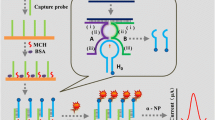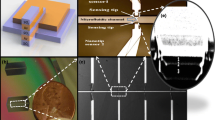Abstract
We review the development of reagentless, electrochemical sensors for the sequence-specific detection of nucleic acids that are based on the target-induced folding or unfolding of electrode-bound oligonucleotides. These devices, which are sometimes termed E-DNA sensors, are comprised of an oligonucleotide probe modified on one terminus with a redox reporter and attached to an electrode at the other. Hybridization of this probe DNA to a target oligonucleotide influences the rate at which the redox reporter collides with the electrode, leading to a detectable change in redox current. Because all sensing elements of this method are strongly linked to the interrogating electrode, E-DNA sensors are label-free, operationally convenient and readily reusable. As E-DNA signaling is predicated on a binding-specific change in the dynamics of the probe DNA (rather than simply monitoring the adsorption of a target to the sensor surface) and because electroactive contaminants (interferents) are relatively rare, this class of sensors is notably resistant to false positives arising from the non-specific adsorption of interferents, and performs well even when challenged directly with blood serum, soil and other complex sample matrices. We review the history of and recent advances in this promising DNA and RNA detection approach.





Similar content being viewed by others
References
Cao YWC, Jin RC, Mirkin CA (2002) Nanoparticles with Raman spectroscopic fingerprints for DNA and RNA detection. Science 297:1536
Gaylord BS, Heeger AJ, Bazan GC (2002) DNA detection using water-soluble conjugated polymers and peptide nucleic acid probes. Proc Natl Acad Sci USA 99:10954
Peterson AW, Wolf LK, Georgiadis RM (2002) Hybridization of mismatched or partially matched DNA at surfaces. J Am Chem Soc 124:14601
Ahn S, Walt DR (2005) Detection of Salmonella spp. using microsphere-based, fiber-optic DNA array. Anal Chem 77 (15):5041
Kelley SO, Barton JK, Jackson NM, Hill MG (1997) Preparation of electrode-immobilized, redox-modified oligonucleotides for electrochemical DNA and aptamer-based sensing. Bioconj Chem 8:31
Cooper MA, Dultsev FN, Minson T, Ostanin VP, Abell C, Klenerman D (2001) Direct and sensitive detection of a human virus by rupture event scanning. Nat Biotechnol 19:833
Endo T, Kerman K, Nagatani N, Takamura Y, Tamiya E (2005) Label-free detection of peptide nucleic acid-DNA hybridization using localized surface plasmon resonance based optical biosensor. Anal Chem 77(21):6976
Patolsky F, Lichtenstein A, Willner I (2001) Preparation of electrode-immobilized, redox-modified oligonucleotides for electrochemical DNA and aptamer-based sensing. J Am Chem Soc 123:5194
Park SJ, Taton TA, Mirkin CA (2002) Array-based electrical detection of DNA with nanoparticle probes. Science 295:1503
Boon EM, Ceres DM, Drummond TG, Hill MG, Barton JK (2000) Mutation detection by electrocatalysis at DNA-modified electrode. Nat Biotechnol 18:1096
Drummond TG, Hill MG, Barton JK (2003) Electrochemical DNA sensors. Nat Biotechnol 21:1192
Thorp HH (1998) Cutting out the middleman: DNA biosensors based on electrochemical oxidation. Trends Biotech 16:117
Katz E, Willner I (2003) Probing biomolecular interactions at conductive and semiconductive surfaces by impedance spectroscopy: routes to impedimetric immunosensors, DNA-sensors, and enzyme biosensors. Electroanalysis 15:913
Gore MR, Szalai VA, Ropp PA, Yang IV, Silverman JS, Thorp HH (2003) Detection of attomole quantities of DNA targets on gold microelectrodes by electrocatalytic nucleobase oxidation. Anal Chem 75:6586
Floch LF, Ho HA, Harding-Lepage P, Bedard M, Neagu-Plesu R, Leclerc M (2005) Ferrocene-functionalized cationic polythiophene for the label-free electrochemical detection of DNA. Adv Mater 17:1251
Gibbs JM, Park SJ, Anderson DR, Watson KJ, Mirkin CA, Nguyen ST (2005) Polymer-DNA hybrids as electrochemical probes for the detection of DNA. J Am Chem Soc 127:1170
Kim E, Kim K, Yang H, Kim YT, Kwak J (2003) Enzyme-amplified electrochemical detection of DNA using electrocatalysis of ferrocenyl-tethered dendrimer. Anal Chem 75:5665
Kerman K, Matsubara Y, Morita Y, Takamura Y, Tamiya E (2004) Recent trends in electrochemical DNA biosensor technology. Sci Technol Adv Mater 5:351
Wang J, Polsky R, Merkoci A, Turner KL 2003 ‘Electroactive beads’ for ultrasensitive DNA detection Langmuir 19:989
Hwang S, Kim E, Kwak J (2005) Electrochemical detection of DNA hybridization using biometallization. Anal Chem 77: 579
Fan C, Plaxco KW, Heeger AJ (2003) Electrochemical interrogation of conformational changes as a reagentless method for the sequence-specific detection of DNA. Proc Natl Acad Sci USA 100:9134
Mao T, Luo C, Ouyang Q (2003) Studies of temperature-dependent electronic transduction on DNA hairpin loop sensor. Nucleic Acids Res 31:108
Immoos CE, Lee SJ, Grinstaff MW (2004) Conformationally gated electrochemical gene detection. Chembiochem 5:1100
Du H, Disney MD, Miller BL, Krauss TD (2003) Hybridization-based unquenching of DNA hairpins on Au surfaces: prototypical “molecular beacon” biosensors. J Am Chem Soc 125:4012
Du H, Strohsahl CM,Camera J, Miller BL, Krauss TD (2005) Sensitivity and specificity of metal surface immobilized molecular beacon biosensors. J Am Chem Soc 127:7932
Wang H, Li J, Liu H, Liu Q, Mei Q, Wang Y, Zhu J, He N, Lu Z (2002) Label-free hybridization detection of a single nucleotide mismatch by immobilization of molecular beacons on an agarose film. Nucleic Acids Res 30:e61
Ramachandran A, Flinchbauch J, Ayoubi P, Olah GA, Malayer JR (2004) Target discrimination by surface-immobilized molecular beacons designed to detect Francisella tularensis. Biosens Bioelectron 19:727
Palecek E (2004) Surface-attached molecular beacons light the way for nucleotide sequencing. Trends Biotechnol 22:55
Thorp HH (2003) Reagentless detection of DNA sequences on chemically modified electrodes. Trends Biotechnol 21:522
Lubin AA, Lai RY, Baker BR, Heeger AJ, Plaxco KW (2006) Sequence-specific, electronic detection of oligonucleotides in blood, soil, and foodstuffs with the reagentless, reusable E-DNA sensor. Anal Chem 78(16):5671
Lubin AA, Fan C, Schafer M, Clelland CT, Bancroft C, Heeger AJ, Plaxco KW (2008) Rapid, electronic detection of DNA and non-natural DNA analogs for molecular marking applications. For Sci Comm 10(1):1
Lai RY, Seferos DS, Heeger AJ, Bazan GC, Plaxco KW (2006) Comparison of the signaling and stability of electrochemical DNA sensors fabricated from 6- or 11-carbon self-assembled monolayers. Langmuir 22:10796
Lai RY, Lagally ET, Lee S-H, Soh HT, Plaxco KW, Heeger AJ (2006) Rapid, sequence-specific detection of unpurified PCR amplicons via a reusable, electrochemical sensor. Proc Natl Acad Sci USA 103:4017
Ricci F, Lai RY, Heeger AJ, Plaxco KW, Sumner JJ (2007) Effect of molecular crowding on the response of an electrochemical DNA sensor. Langmuir 23:6827
Xiao Y, Lai R, Plaxco KW (2007) Preparation of electrode-immobilized, redox-modified oligonucleotides for electrochemical DNA and aptamer-based sensing. Nature Protocols 2:2875
Lai RY, Lee S-H, Soh HT, Plaxco KW, Heeger AJ (2006) Differential Labeling of Closely-spaced Biosensor Electrodes via Oxidative Desorption. Langmuir 22:1932
Pavlovic E, Lai RY, Wu TT, Ferguson BS, Sun R, Plaxco KW, Soh HT (2008) Specific, electromechanical detection of multiple DNA sequences in an integrated microfluidic system. Langmuir 24(3):1102
Annse A, Demaille C (2006) Dynamics of electron transport by elastic bending of short DNA duplexes.Experimental study and quantitative modeling of the cyclic voltammetric behavior of 30-ferrocenyl DNA endgrafted on gold. J Am Chem Soc 128:542
Ricci F, Lai RY, Plaxco KW (2007) Linear, redox modified DNA probes as electrochemical DNA sensors. Chem Comm 2007:3768
Immoos CE, Lee SJ, Grinstaff MW (2004) DNA–PEG–DNA triblock macromolecules for reagentless DNA detection. J Am Chem Soc 126:10814
Xiao Y, Lubin AA, Baker BR, Plaxco KW, Heeger AJ (2006) Single-step electronic detection of femtomolar DNA by target-induced strand displacement in an electrode-bound duplex. Proc Natl Acad Sci USA 103:16677
Xiao Y, Qu X, Plaxco KW, Heeger AJ (2007) Label-free electrochemical detection of DNA in blood serum via target-induced resolution of an electrode-bound DNA pseudoknot. J Am Chem Soc 129(39):11896
Author information
Authors and Affiliations
Corresponding author
Rights and permissions
About this article
Cite this article
Ricci, F., Plaxco, K.W. E-DNA sensors for convenient, label-free electrochemical detection of hybridization. Microchim Acta 163, 149–155 (2008). https://doi.org/10.1007/s00604-008-0015-4
Received:
Accepted:
Published:
Issue Date:
DOI: https://doi.org/10.1007/s00604-008-0015-4




